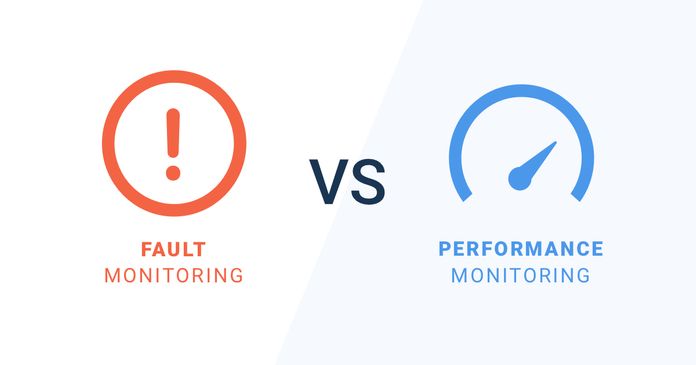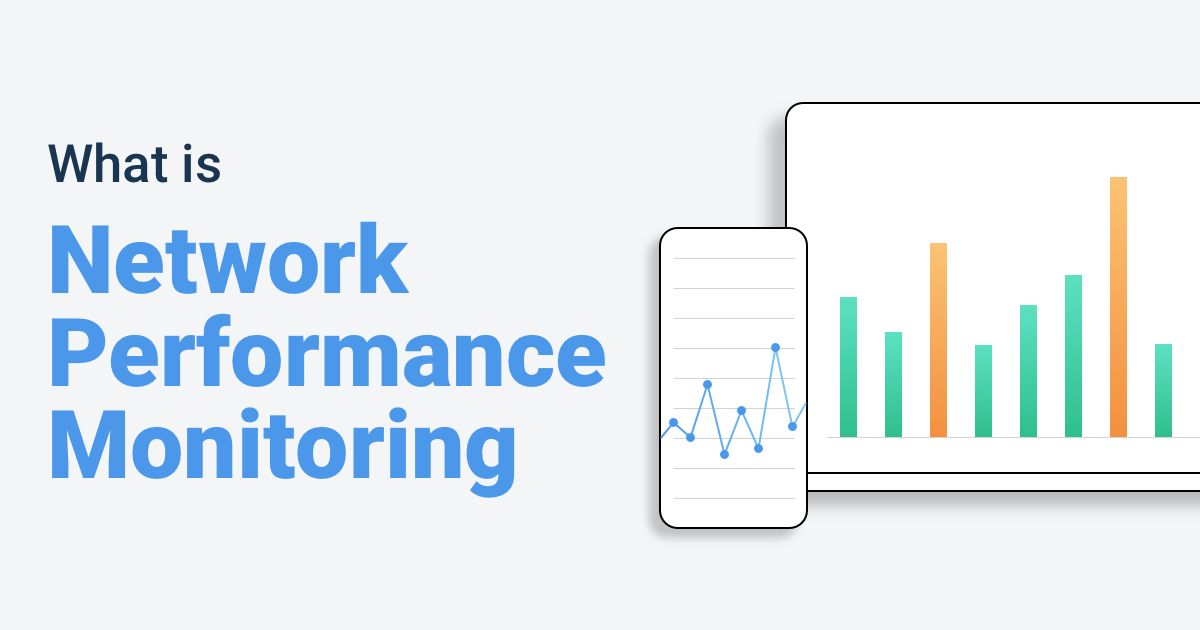Table of Contents
Table of Contents
Welcome, network enthusiasts! In our exciting blog post, "Top 7 Reasons Why You Should Monitor Network Performance," we'll explore the top reasons to monitor network performance and the importance of network performance monitoring. We'll also explain the benefits of implementing network monitoring software. Prepare for a thrilling journey as we uncover the secrets behind flawless connectivity, vanquishing latency, and fortifying cybersecurity. Let's dive in and conquer the digital universe together!
Modern networks are complex beasts. With this complexity comes many opportunities for things to go wrong. Additionally, networks are often the backbone of businesses, and so when they don’t perform to the best of their capabilities, your business may suffer. As a network administrator, this is certainly something you’d rather avoid.
One of the best ways to avoid business-impacting issues is to see them coming and fix them before they have a chance to wreak havoc.
This is where Network Performance Monitoring comes in.
Network Performance Monitoring is the analysis and review of network performance as seen by end-users to identify network performance issues and optimize network performance. It differs from traditional monitoring because performance is monitored from the end-user perspective, and is measured between two points in the network.
For example:
- The performance between a user, who works in the office, and the application they use in the company’s data center
- The performance between two offices in a network
- The performance between the head office and the Internet
- The performance between your users and the cloud
The primary objective of network performance monitoring is to guarantee the smooth and optimal functioning of the network while promptly detecting and resolving network availability and performance issues. To achieve this, various essential network metrics such as network traffic, bandwidth utilization, packet loss, latency, and more are collected and analyzed using diverse tools and techniques.
By harnessing the insights obtained from network performance monitoring, organizations can establish or elevate their network performance standards. This valuable data aids in troubleshooting and resolving network problems efficiently, empowering informed decision-making regarding network capacity, infrastructure priorities, and future planning.
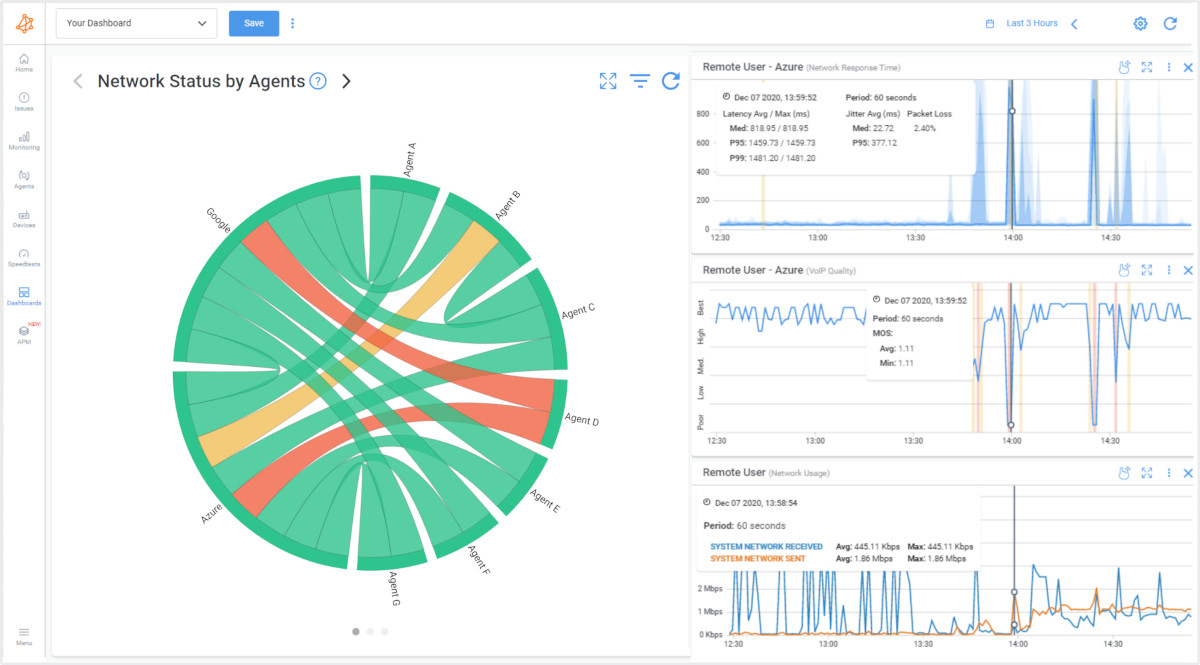

Network performance monitoring is a crucial task for any business that relies on computer networks for its daily operations. To achieve optimal network performance, businesses employ a variety of Network Performance Monitoring tools and techniques to monitor and analyze network traffic, identify bottlenecks, and troubleshoot issues.
One of the most significant aspects of network performance monitoring is the use of specialized tools designed to collect and analyze network data in real-time, enabling businesses to stay on top of issues as they arise. Network Performance Monitoring tools work tirelessly, ensuring that no problems go unnoticed, and helping businesses maintain optimal network performance.
Network Performnance Monitoring can be done using an NPM software or tool, like Obkio.
Obkio Network Performance Monitoring (NPM) is a continuous network monitoring and troubleshooting SaaS solution to help you identify and troubleshoot intermittent network issues and improve the end-user experience.

- Obkio is SaaS-based: So it can be deployed in 10 minutes and doesn't require any special configurations. This means that you can start monitoring network performance quickly, and can easily scale the solution to your business’ needs.
- End-to-End: Obkio measures every end of your network, from LAN monitoring to WAN monitoring, using Network Monitoring Agents. You can deploy Agents in all your branch offices, remote locations, data centers, Clouds and over the Internet. It can also support all (SD-WAN, MPLS, Hybrid, Dual-WAN, VPN, Internet Multihoming and more).
- Synthetic Monitoring: Obkio measures network performance using synthetic UDP traffic, which means there’s no packet capture required and no privacy concerns for users.

To begin monitoring network performance, you need to deploy Network Monitoring Agents which continuously measure network performance in key network locations. Here’s what we recommend:
- Local Agents: Installed in the targeted office location experiencing connectivity issues. There are several Agent types available (all with the same features), and they can be installed on MacOS, Windows, Linux and more.
- Public Monitoring Agents: Which are deployed over the Internet and managed by Obkio. They compare performance up to the Internet and quickly identify if the problem is global or specific to the destination. This will be great information for later in the troubleshooting process. You can use an AWS or Google Cloud Agent.
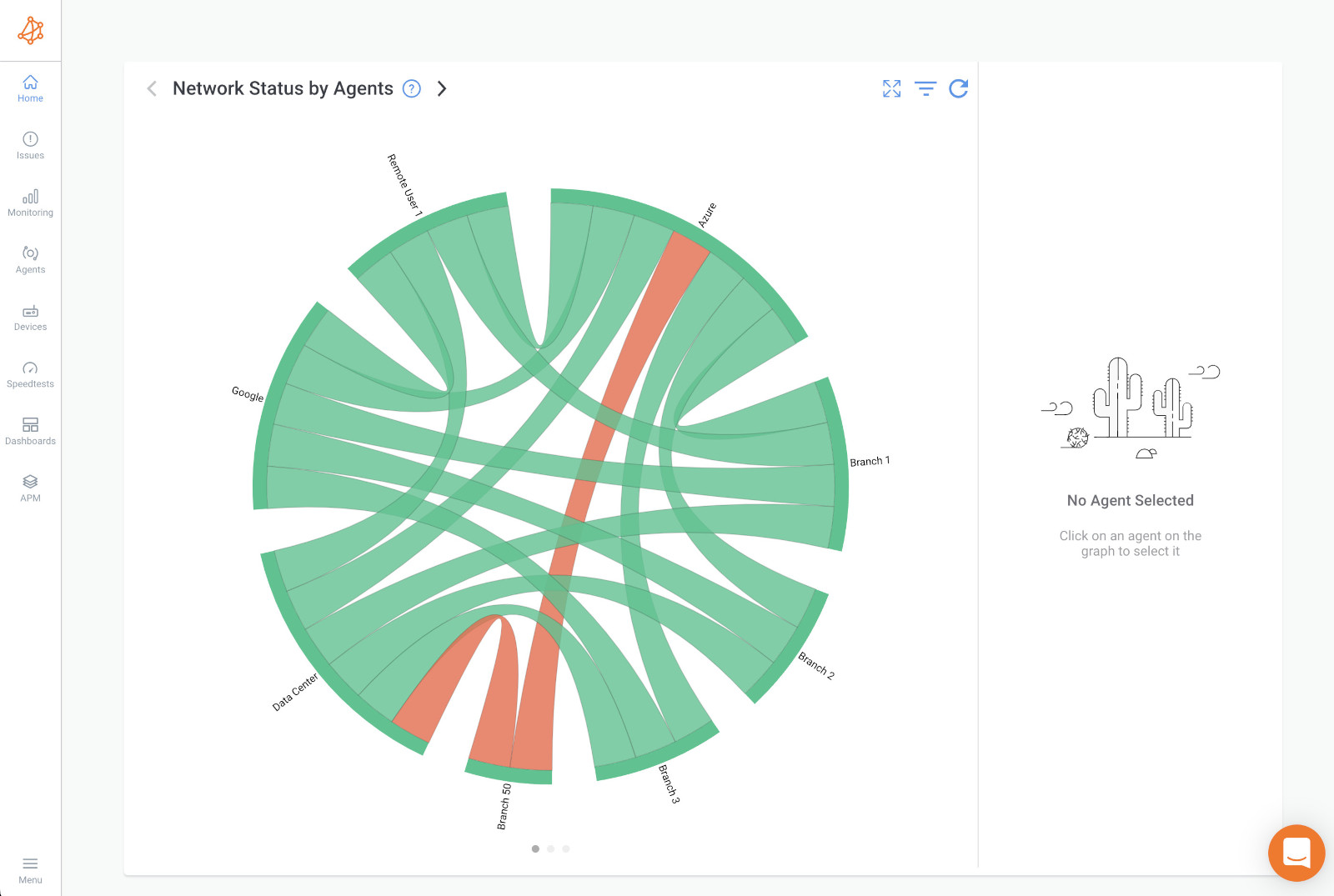
Once you’ve deployed your Network Performance Monitoring tool, Obkio’s Monitoring Agents will start exchanging traffic to measure network metrics like jitter, packet loss, and latency and display them on Obkio’s Network Response Time Graph.
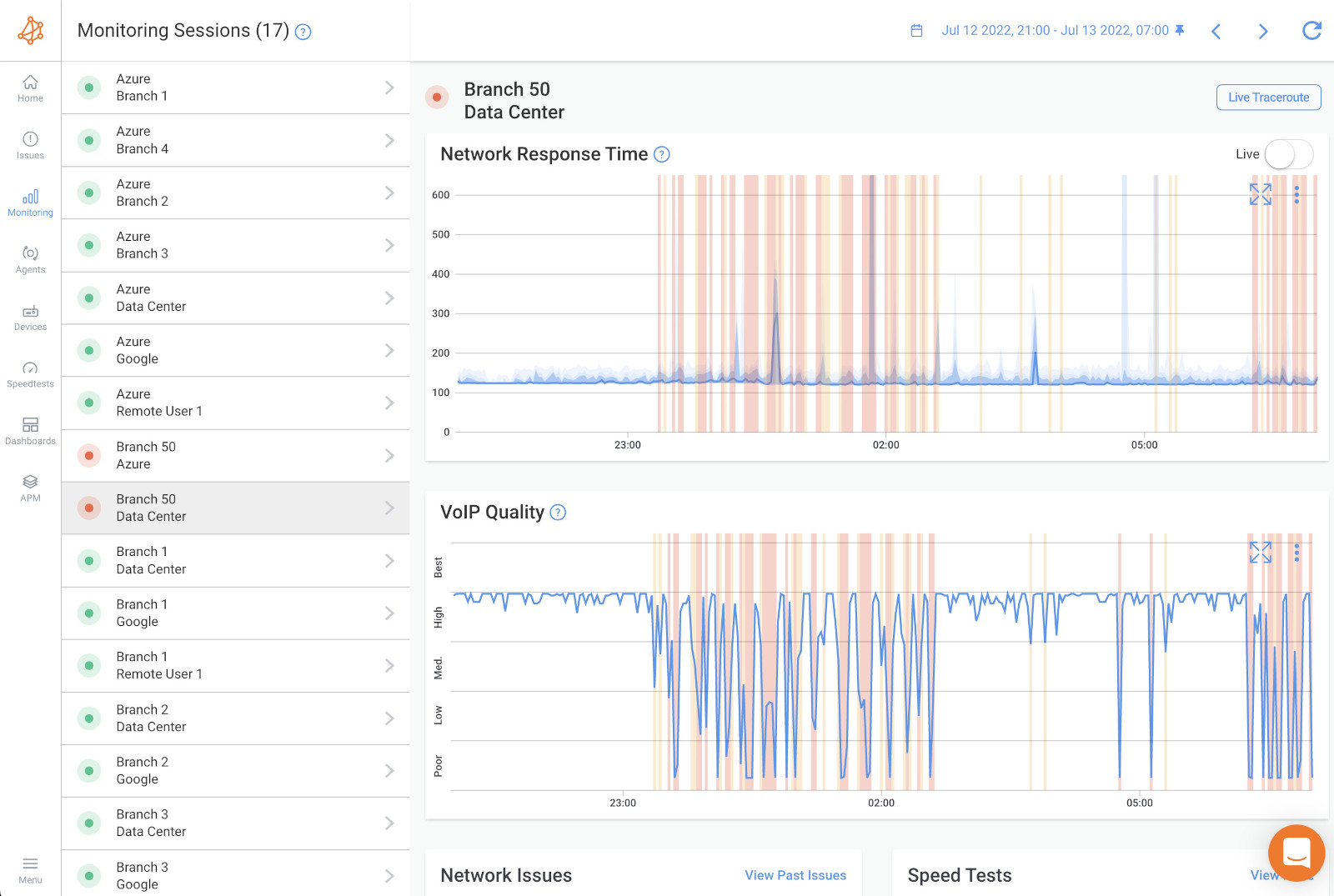
By measuring these essential network metrics, you gain valuable insights into the performance of your network, enabling you to swiftly identify any signs of degradation that may foreshadow impending network issues. With Obkio, you receive real-time updates on your network performance every minute, ensuring that no problems escape your attention.
You also have the power to delve into historical performance data, allowing you to troubleshoot and resolve network issues from the past. Rest assured, with Obkio by your side, you'll stay one step ahead, proactively addressing network challenges like a true champion.
You can now use all the data you’ve collected to actually identify network problems and collect the information you’ll use to troubleshoot.
With Obkio, you can create your own dashboards and reports, get network monitoring alerts for network issues, and use advanced tools like Obkio Vision: Visual Traceroute Tool to troubleshoot internally or externally with your Service Provider.
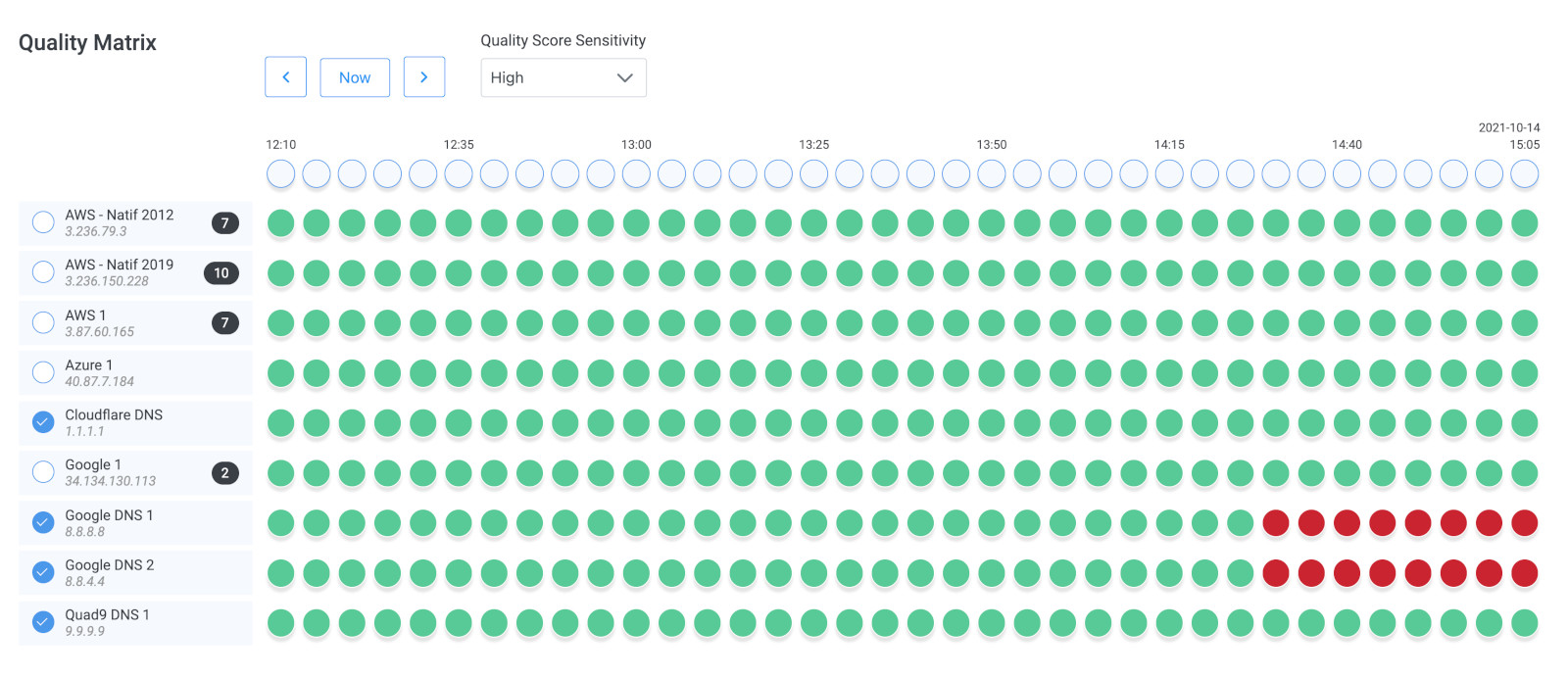
In the ever-evolving world of technology, the importance of Network Performance Monitoring cannot be overstated. For businesses relying on computer networks, it serves as a vital lifeline to success. In this section, we delve into the compelling reasons why Network Performance Monitoring is an absolute game-changer for your business.
Network Performance Monitoring plays a crucial role in the success of businesses relying on computer networks. Let's dive into the reasons why it holds such importance:
- Optimal Performance: Network Performance Monitoring allows businesses to ensure that their networks operate at peak efficiency. By monitoring key metrics like network traffic, latency, bandwidth usage, and packet loss, businesses can identify bottlenecks, congestion, or other issues that may degrade network performance. Proactively addressing these issues helps maintain smooth operations, enhances productivity, and provides a seamless experience for employees and customers alike.
- Issue Detection and Resolution: Network Performance Monitoring enables businesses to swiftly detect and address network problems before they escalate. By continuously monitoring network metrics, such as sudden spikes in latency or increased packet loss, businesses can identify potential issues early on and take immediate action to resolve them. This proactive approach minimizes downtime, prevents disruptions, and ensures uninterrupted access to critical applications and services.
- Enhanced User Experience: In today's digital landscape, user experience is paramount. Network Performance Monitoring allows businesses to deliver a superior user experience by optimizing network performance. By monitoring metrics like response times and network availability, businesses can identify areas for improvement and fine-tune their network infrastructure accordingly. This results in faster and more reliable access to applications, websites, and services, leading to increased customer satisfaction and loyalty.
- Capacity Planning and Scalability: Network Performance Monitoring provides valuable insights for capacity planning and scalability. By analyzing historical performance data and trends, businesses can accurately forecast future network requirements and make informed decisions regarding network upgrades, bandwidth allocation, and infrastructure investments. This proactive approach ensures that the network can accommodate growing demands and adapt to changing business needs effectively.
- Security and Compliance: Network Performance Monitoring plays a vital role in ensuring network security and compliance. By monitoring network traffic patterns and anomalies, businesses can detect potential security breaches, unauthorized access attempts, or abnormal behavior. This allows for timely response and mitigation of security threats, protecting sensitive data and maintaining regulatory compliance.
But that's just a little overview - now let's go into more depth with the top 7 reasons to monitor network performance:
Any network administrator knows that as soon as things start to slow down, everyone is quick to point the finger at the network. There’s a simple reason for that:
The network is often the culprit. However, often doesn’t mean always.
The network is only one component of most IT environments, albeit an important one. Many subsystems are part of a typical service delivery environment. Some components can even be hosted in a public cloud, making it even harder to pinpoint the exact location of a fault and, more importantly, determine who is responsible for fixing it.
One such typical case would be an OTT VoIP service hosted on Amazon AWS or Microsoft Azure. In this situation, an administrator’s first instinct will lead them to contact their VoIP Service Provider after making sure that the problem is not within the local network. Chances are that the VoIP provider will say that the issue is not on their side and will blame the Internet.
We’ve all been on one of these never-ending conference calls with multiple providers where everyone seems to be pointing fingers and blaming someone else. No one wants the problem to be on their side mostly because no one has the proper tools to diagnose the issue.
By setting up a performance monitoring solution and by deploying monitoring agents in strategic locations, it becomes possible to lay out very clearly the responsibility domain of the various groups involved in delivering a given service. It essentially performs a network assessment for you, to gather information about:
- The cause and source of the network problems.
- Where and when it happened.
- and who is responsible for fixing it.
Furthermore, this performance monitoring solution lets every party involved pinpoint the source of the problem quickly and irrefutably, compelling the responsible group to take any necessary corrective actions.
Stop looking for the perfect reason. Just try it. You'll be deployed and testing it live in 10 minutes.
Networks may be complex. But Obkio makes network monitoring easy. Monitor, measure, pinpoint, troubleshoot, and solve network problems.
- 14-day free trial of all premium features
- Deploy in just 10 minutes
- Monitor performance in all key network locations
- Measure real-time network metrics
- Identify and troubleshoot live network problems

You can rest assured that we're not like those pushy Sellsy people - there's no catch here. We firmly believe in the excellence of our product, but if it's not the right fit for you, we understand and want what's best for you.
Identifying network performance issues from the user’s point of view can often be a challenge. Even more so when that user is the big boss. But detecting issues before they get noticed by users is the most difficult challenge - it’s also one of the most important reasons to monitor network performance.
Although we have often have the means to measure performance between our data centers and branch office firewalls, it won’t be of much help to troubleshoot a performance issue that someone in a remote office encounters when communicating with another remote office.
In addition, performance monitoring systems can often detect minute performance changes that could be advanced signs of some impending problem. They will literally let you detect issues before they start affecting users.


Traditional monitoring tools—like those that use SNMP polling, for instance—are not designed to provide performance statistics from a user’s point of view. They mostly are reactive tools that, while helpful for troubleshooting existing issues, are not the right tools for the early detection of performance issues, especially not from a user’s perspective.
Deploying a performance monitoring solution gets all the blind spots left by most traditional monitoring tools covered. It collects detailed information about the reasons for poor network performance within your network.
A performance monitoring tool will:
- Simulate real user traffic and will therefore measure the real performance experienced by your users. This is a Synthetic Monitoring technique.
- Establish a network performance baseline measurement of each segment of your network. This is a very important feature as it will allow you to detect even the smallest performance degradation.
- Deploy monitoring agents to constantly monitor your network’s performance from everywhere and from every angle.
- Quickly identify —and solve—issues as soon as they arise.
You’ll often be able to fix issues before they are noticed by users—or your boss during his annual board meeting while live streaming a real-time video presentation—and, although that won’t make you look like a superhero, it will keep everyone happy, and that should be the primary goal.
Most network monitoring solutions on the market are actually fault monitoring systems. They will typically poll devices on a regular basis to ensure that they are up and running, and will alert you if and when they are not. Learn the difference between Fault Monitoring and Network Monitoring in this article.
IT Pros are used to Network Fault Monitoring but what about Network Performance Monitoring? What's the difference?
Learn more

The best ones will also read some operational parameters from the polled devices using SNMP monitoring. And likewise, they will alert you whenever some metric is abnormal. But as useful as some—or all—of this information may be, it does not say much about how the network is actually performing at any given time and between any two points from a user’s point of view.
On the other hand, true performance monitoring tools can help detect and troubleshoot any performance degradation.
Haven’t you ever faced a situation where everyone complains about the performance of the network yet your monitoring tools are telling you that everything is alright? This is a typical case of using the wrong tool.
Continuous network monitoring systems can simulate real user traffic between multiple points on your network and measure its actual performance—from a user’s standpoint.
It’s like having network administrators everywhere constantly testing network performance.
Whenever a slowness issue is reported, the monitoring tool’s strategically located agents will help you quickly pinpoint the exact location of the issue and help resolve it quickly.


When diagnosing network issues, a plethora of tools are available, allowing one to take steps to identify whether there really is a problem or not, its nature, and its location.
- Ping, which will send echo packets to a host and measure the host’s response time is the first such tool that comes to mind.
- Traceroute is another useful tool which will use successive echo packets to display the path to the destination as well as the response time of each hop.
- Web-based tools such as speedtest are also useful in evaluating the performance of your Internet access.

However, many of these tools’ usefulness is limited if you don’t have anything to compare the measured data to.
For instance, perhaps that 60 ms network response time between the head office and a remote location is "normal." Without knowing what the usual value is, it’s hard to establish for sure that there is an issue.
What you need, then, is a means to establish a network baseline of your network’s performance, and this is precisely one of the things a performance monitoring tool can do for you.
Well, when should an administrator establish a network baseline? The best answer is - always.
With the historical data which is collected by a performance monitoring tool, you get the benefit of having access to a comparison point. Another huge advantage of these systems is that they are able to automatically and continuously compare the current data to the historical one and raise an alert as soon as performance starts to degrade.
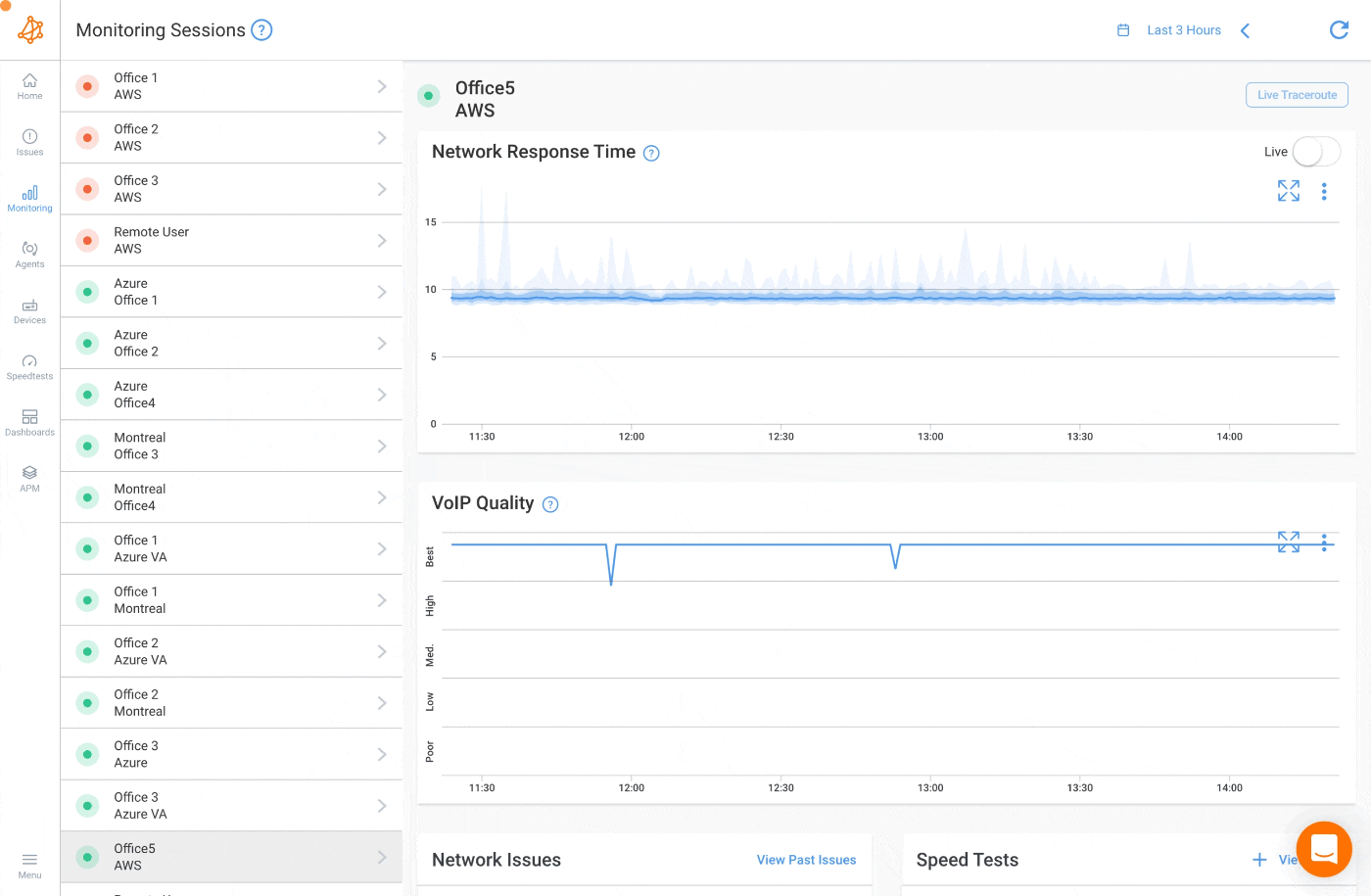
Historical data also brings another important benefit: It can allow an administrator to troubleshoot a past event.
Suppose you come in on a Tuesday morning after a long weekend and find an email from a user complaining about poor performance last Saturday afternoon. Having access to historical data could help you troubleshoot that issue even though things might have since returned to normal. It will let you identify exactly when and where the problem occurred and help you ensure it never happens again.
To summarize, the benefits of historical data include:
- A comparison point between optimal and poor network performance.
- Alerts you of any performance degradation.
- Allows you to troubleshoot past network events.
5. Monitor Network Performance to Ensure A Smooth Migration to the Cloud (w/ Distributed Monitoring)
For the past fifteen years or so, it’s been quite common for organizations with multiple sites to adopt a "centralized" telecom architecture and interconnect all locations to one single, unified network. This allowed businesses to keep their data and its processing within the head office and/or data centers. It was also typical to have a centralized Internet gateway shared by users from all locations.
That way, companies only needed to monitor network performance between the head office or data center and the remote locations. This provided sufficient coverage to catch most business-impacting issues and for that, traditional monitoring systems were usually adequate.

Organizations—which were rarely using Internet-based VPN connections—used MPLS networks which, although expensive, offered guaranteed quality of service (QoS). Issues associated with network metrics like packet loss, latency, or jitter were uncommon and so were performance monitoring tools.
They simply were not needed and their return on investment was difficult to demonstrate. Bandwidth monitoring was typically all those enterprises needed.
Flash-forward to today and things are quite different. Organizations are increasingly using cloud-hosted applications services. And this is not only the case with office tools such as Office 365 from Microsoft or Google Workplace from Google. They also use that model for business-critical applications such as ERP, CRM, and other project management tools.
Accessing these services through a centralized Internet gateway—often hundreds if not thousands of miles away—is no longer acceptable. The few milliseconds of round trip time added to each transaction quickly adds up to a considerable delay. Businesses are, therefore, reverting to using local Internet gateways in each location.
The transition to cloud-based services has led organizations to leave the centralized model and switch to a more distributed architecture. Unfortunately, this can quickly complexify the data flows between users, thereby rendering traditional monitoring tools less interesting. They’re simply not up to the task.
This is where you need a distributed network monitoring solution which can truly monitor the network’s performance from a user’s perspective and from every possible angle.
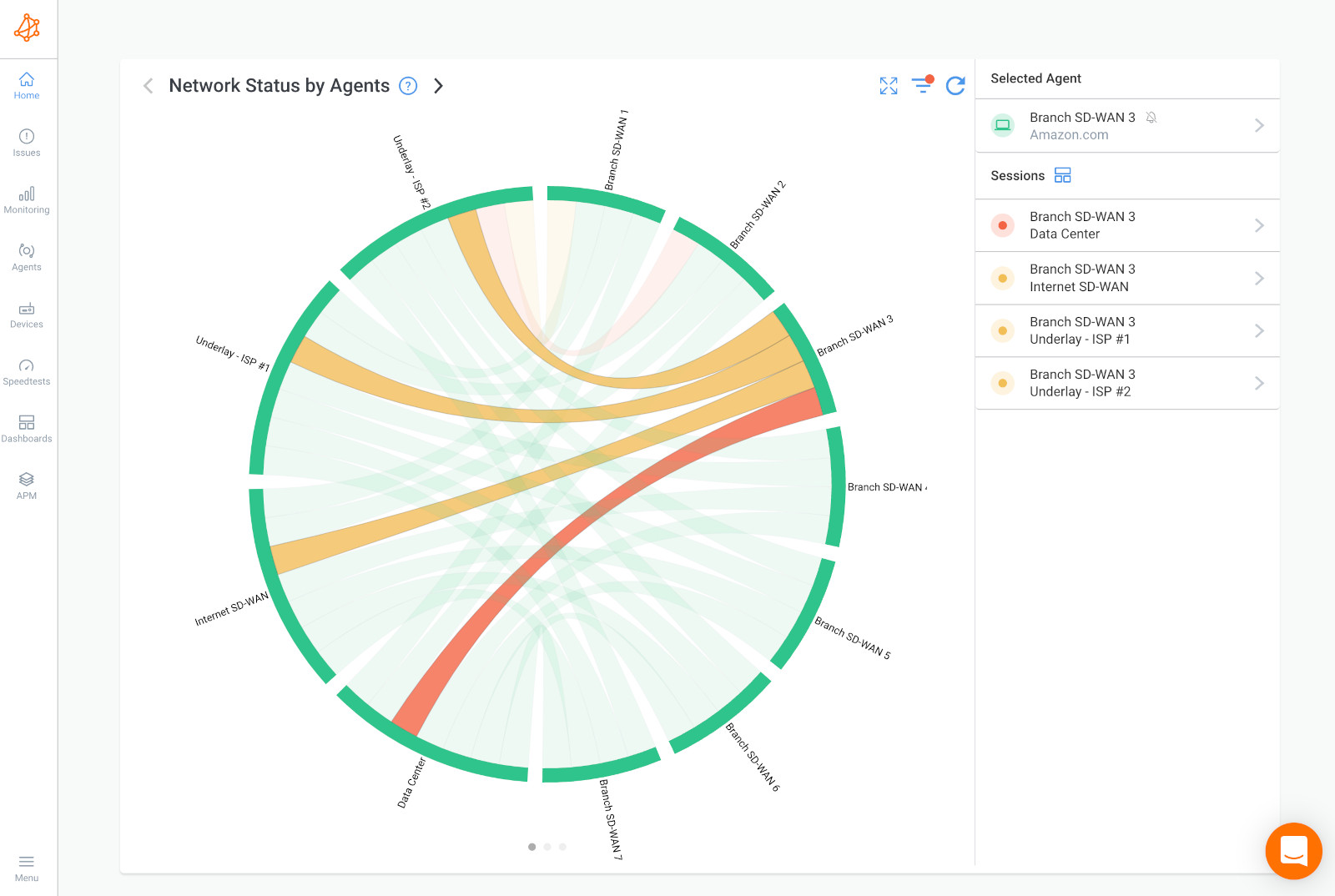

Pro-Tip: Obkio’s Cloud Performance Monitoring Solution is a decentralized solution made to monitor network performance up to your cloud infrastructure for applications like ERP, CRM, Microsoft 365, G Suite and more!
Centrally managed IT is an ever-growing trend, and since organizations no longer have IT resources in remote offices, most IT assets are being hosted at the head office—or in a dedicated data center—alleviating the need for remote IT resources.
But while IT assets might be limited in remote locations, some equipment such as networking equipment is still there. A consequence of this centralization is that IT resources are getting scarce, teams are getting smaller, and the need for great tools is more pressing than ever.
When you need to manage multiple networks—some in very remote locations and with limited WAN connectivity—with no on-site staff, what you need is a way to "virtually" have people in each location.
Network performance monitoring, specifically a remote network monitoring solution, tools can offer that functionality, and they can operate over any type of WAN connection. A good performance monitoring solution will be able to monitor SD-WAN networks, VPN, MPLS, SASE, or whatever WAN connectivity you have.
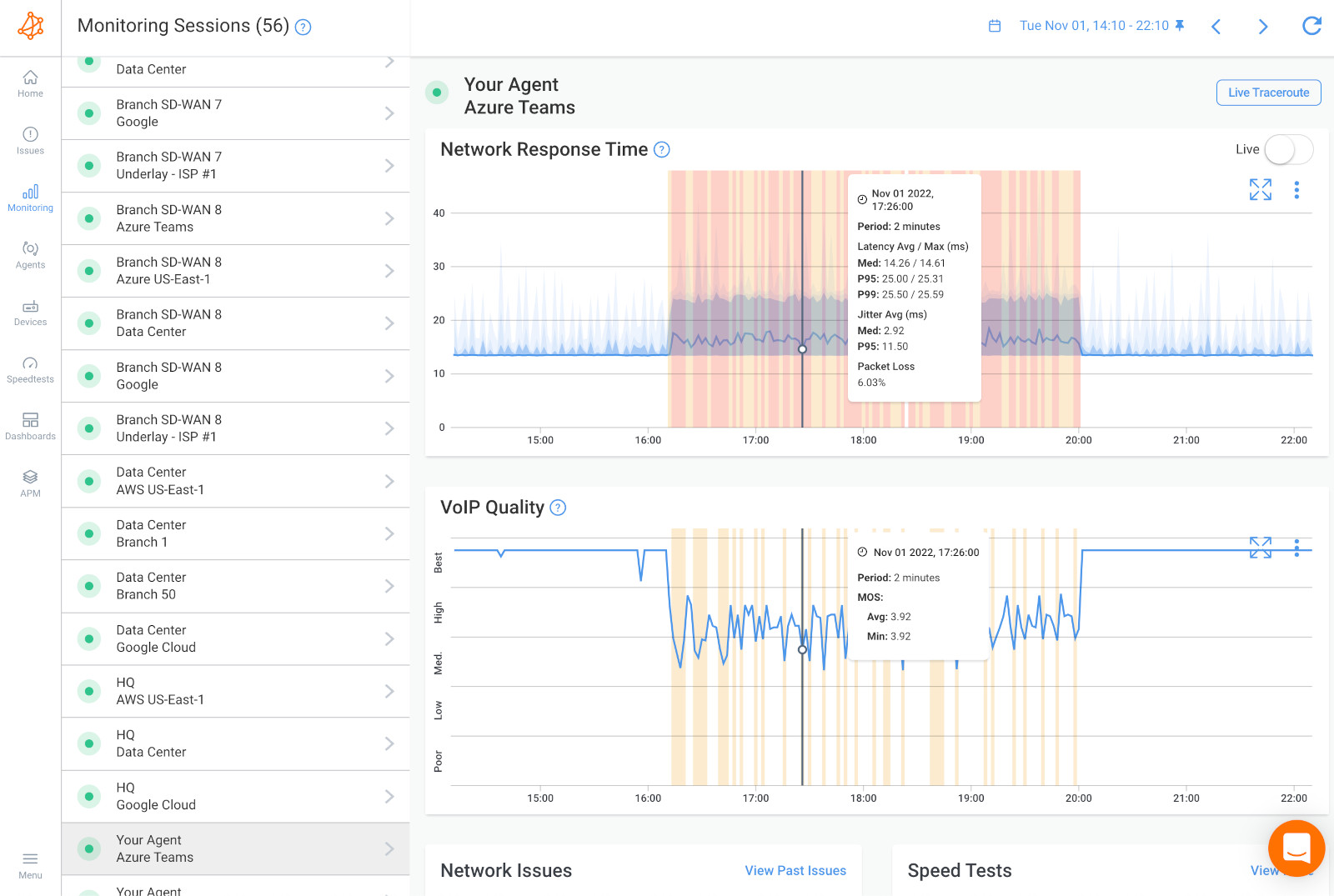
As we hinted earlier, deploying a performance monitoring solution throughout your network with strategically placed agents will give you visibility in the most remote sites to - even enough to troubleshoot network problems from home.
You can be confident that the agents are constantly measuring and evaluating the performance of the network from a true user’s perspective. Even more importantly, the agents do it on a continuous basis, day and night.
Try to get that from IT staff!
Network performance monitoring will often let you identify network performance issues that more traditional monitoring tools may be overlooking.
One of the reasons is that they simulate real usage scenarios. It’s like having IT staff everywhere constantly running tests! All the performance data that is gathered by performance monitoring tools can be used to your advantage.
One of the best ways this data can be used is capacity planning in a very broad sense. We’re not just talking about throwing in more bandwidth. Any bandwidth monitoring solution can help you with that. With true performance monitoring tools, you can make the proper network diagnostic and ask yourself the right questions about various aspects of your network such as:
- The inherent design of the network
- The necessary equipment acquisitions or upgrades
- The sizing of the networking equipment
- The performance of your service providers (including their SLAs)
- The operation and maintenance of the network
This data can also be analyzed and used to help you:
- Make the right decisions about custom-building or expanding your network.
- Provide invaluable insight when managing costs and prioritizing network improvement investments.
- Help identify the need for additional internal or external resources.
Choose your Ultimate Fighter: Network Performance Monitoring tool to ensure optimal network performance. Learn about the types of tools, features & uses.
Learn more

There are many reasons why network performance is important and why one would want to deploy a network performance monitor. Some network monitoring use cases have to do with:
- Assuring the performance of the network.
- Detecting and fixing intermittent network issues.
- Addressing the needs of reduced IT staff teams with limited remote resources.
- Provide decision-making data that can be used in many different ways.
The key element here is that performance monitoring tools do provide much more useful operational data about your network than any other type of monitoring tools can. This does not mean that your good old SNMP monitor is not good anymore, but it could certainly be complemented by deploying a performance monitoring solution which, in a nutshell, starts where the other tools stop.

Now that you understand why network monitoring is important, you can see just how easy it is! Try your hand at network performance monitoring with a free trial of Obkio’s network performance monitoring software!
Obkio is a simple network performance monitoring solution that allows users to continuously monitor the health of their network and core business applications to improve the end-user experience.
- 14-day free trial of all premium features
- Deploy in just 10 minutes
- Monitor performance in all key network locations
- Measure real-time network metrics
- Identify and troubleshoot live network problems

You can rest assured that we're not like those pushy Sellsy people - there's no catch here. We firmly believe in the excellence of our product, but if it's not the right fit for you, we understand and want what's best for you.












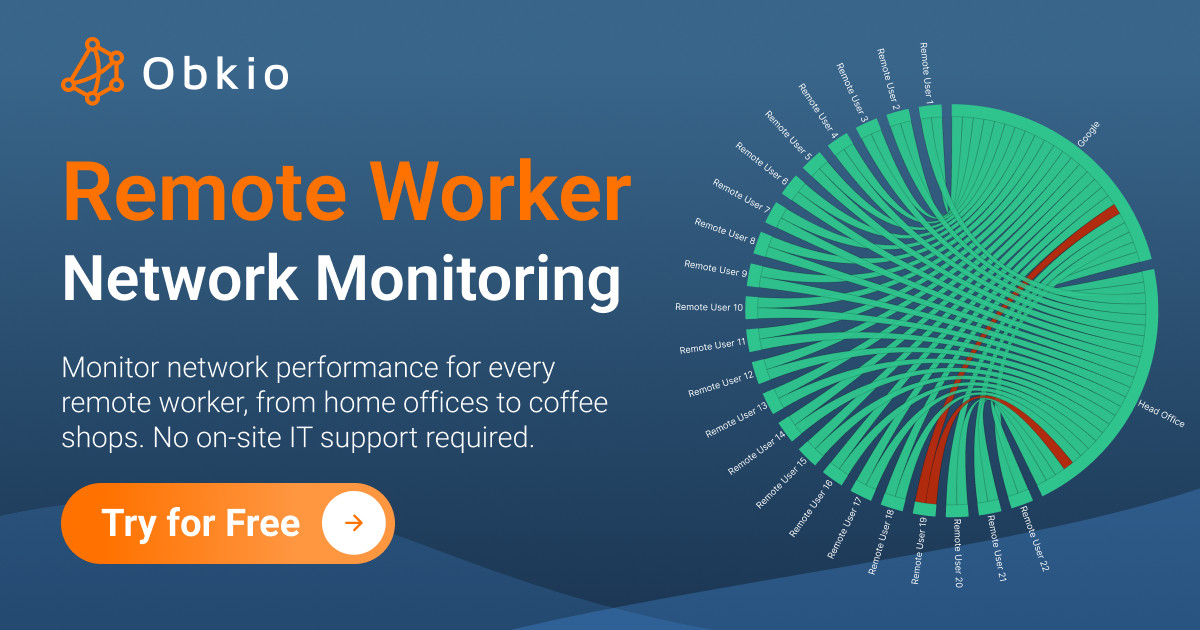













 Obkio Blog
Obkio Blog






